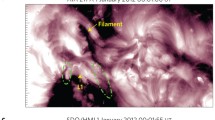Abstract
Based on the studies on the source regions of a group of coronal mass ejections, we have identified two types of large-scale magnetic structures, and suggested that they are intrinsic components of solar magnetism, their destabilization, expansion, and eruption into the interplanetary space are the basic physical processes which lead to the coronal mass ejections. These two types of large-scale structures are giant magnetic loops connecting the two active belts on the opposite hemispheres of the Sun, and the giant filaments (filament channels) and their related magnetic structures. The latter often appear as two parallel rows of sunspots and plage fields, which align side by side in the full disk daily and synoptic magnetograms. The magnetic neutral lines of these large-scale structures are usually longer than 50 heliographic degrees. We name this type of structure “super A configuration”. Sometimes, they are shown as very long filaments and related large-scale magnetic fields. As these magnetic structures are of very large scale, they extend to a great altitude into the corona, they are not easily recognized in magnetic field observations which are usually aimed at solar flare studies. To identify these large-scale structures becomes a key to understanding and predicting coronal mass ejections.
Similar content being viewed by others
References
Gosling, J. T., The solar flare myth, J. Geophys. Res., 1993, 98: 18937–18950.
Brueckner, G. E., Howard, R. A., Koomen, M. J. et al., The large angle spectroscopic coronagraph (LASCO), Solar Phys., 1995, 162: 357–402.
Delaboudiniere, J. -P., Artzner, G. E., Brunaud, J. et al., EIT: Extreme-ultraviolet imaging telescope for the SOHO mission, Solar Phys., 1995, 162: 291–312.
Scherrer, P. H., Bogart, R. S., Bush, R. I. et al., The solar oscillations investigation—Michelson Doppler imager, Solar Phys., 1995, 162: 129–188.
Ogawara, Y., Takano, T., Kato, T. et al., The solar-A mission—An overview, Solar Phys., 1991, 136: 1–16.
Howard, R. A., Michels, D. J., Sheeley, N. R. Jr. et al., The observation of a coronal transient directed at Earth, Astrophys. J., 1982, 263: L101–104.
Webb, D. F., Lepping, R. P., Burlaga, L. F. et al., Relationship of halo coronal mass ejections, magnetic clouds and magnetic storm, J. Geophys. Res., 2000, 105: 7491–7508.
Thompson, B. J., Plunkett, S. P., Gurman, J. B. et al., SOHO/EIT observations of an Earth-directed coronal mass ejection, Geophys. Res. Lett., 1998, 25: 2465–2468.
Feynman, J., Martin, S. F., The initiation of coronal mass ejections by newly emerging, J. Geophys. Res., 1995, 100: 3355–3367.
Delannee, C., Delaboudiniere, J.-P., Lamy, P., Observation of the origin of CMEs in the low corona, 2000, Astron. Astrophys., 1998, 355: 725–742.
Avignon, Y., Martres, M. J., Pick, M., Identification de classes d’éruptions chromosphériques associées aux émissions de rayons cosmiques et à l’activité radioélectrique, Annales d’Astrophysique, 1964, 27: 23–28.
Zhang, J., Wang, J. X., Deng, Y. Y. et al., Magnetic flux cancellation associated with the major solar event on 2000 July 14, Astrophys. J., 2001, 548: L99-L102.
Zhang, J., Wang, J. X., Filament eruptions and halo coronal mass ejections, Astrophys. J., 2001, 554: 474–487.
Zhang, J., Wang, J. X., Nitta, N., A filament-associated halo coronal mass ejection, Chinese J. Astron. Aastrophys., 2001, (1): 85–98.
Author information
Authors and Affiliations
Corresponding author
Rights and permissions
About this article
Cite this article
Wang, J., Zhang, J., Deng, Y. et al. Large-scale magnetic structures of coronal mass ejections. Sci. China Ser. A-Math. 45 (Suppl 1), 57–64 (2002). https://doi.org/10.1007/BF02889685
Received:
Revised:
Issue Date:
DOI: https://doi.org/10.1007/BF02889685




